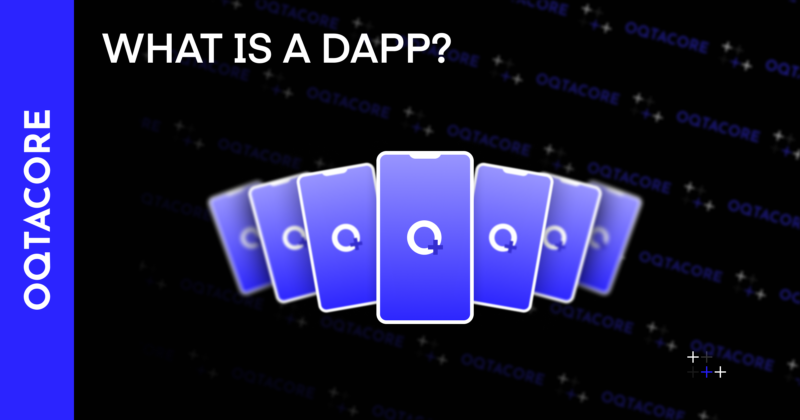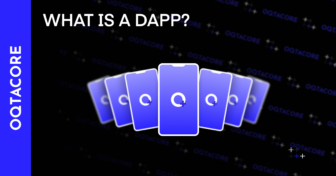
Discover DApps and learn 12 essential steps to build secure, trustless decentralized applications in 2025 with Oqtacore.
Introduction
Decentralized applications (DApps) are reshaping industries by enabling secure, trustless, and transparent interactions on blockchain networks. Unlike traditional apps, DApps operate on decentralized infrastructures, removing middlemen, reducing fraud, and giving users more control.
From DeFi protocols to NFT marketplaces and Web3 social networks, DApps are redefining digital experiences. This guide outlines 12 essential steps to build a scalable and secure DApp – from planning and development to security and deployment.
1. Define Your DApp’s Purpose and Value
A successful DApp starts with a clear purpose.
- What problem does it solve? (Finance, gaming, identity, governance, etc.)
- Why blockchain? (Immutability, transparency, decentralization)
- Who is the target audience? (Retail users, developers, businesses, DAOs)
Example: Uniswap transformed trading by enabling decentralized, permissionless token swaps, eliminating reliance on centralized exchanges.
2. Choose the Right Blockchain
Each blockchain has unique advantages. Selecting the right one depends on scalability, fees, and ecosystem support.
- Ethereum – Largest DApp ecosystem, ideal for DeFi, DAOs, and NFTs.
- Solana – High-speed, low-cost transactions for gaming and finance applications.
- Polygon – Ethereum-compatible with lower fees and faster confirmations.
- BNB Chain – Strong adoption in DeFi and gaming.
- Cosmos & Polkadot – Best for cross-chain interoperability.
For cost efficiency, Layer 2 solutions like Arbitrum and Optimism reduce transaction fees and improve scalability.
3. Select the Smart Contract Language
DApps rely on smart contracts, self-executing programs that run on blockchains. Popular programming languages include:
- Solidity (Ethereum, BNB Chain, Polygon) – The most widely used for EVM-compatible DApps.
- Rust (Solana, Near, Polkadot) – High-performance and memory-safe.
- Move (Aptos, Sui) – Designed for security-focused applications.
Use frameworks like Hardhat, Foundry, or Remix to streamline development and testing.
4. Define Tokenomics and Governance
If your DApp involves tokens or governance, a well-balanced economic model is crucial.
- Token Supply: Fixed vs. inflationary models.
- Utility: Staking, governance, payments, or rewards.
- Revenue Model: Transaction fees, premium features, DAO governance.
Example: Aave enables governance through staked AAVE tokens, allowing users to vote on protocol decisions.
5. Develop and Test Smart Contracts
Writing secure smart contracts is essential. Follow these best practices:
- Use pre-audited libraries (e.g., OpenZeppelin for Solidity).
- Prevent vulnerabilities (e.g., reentrancy attacks, access control misconfigurations).
- Conduct thorough testing using frameworks like Hardhat, Truffle, or Foundry.
Automated security tools like Slither and MythX help detect vulnerabilities before deployment.
6. Build the Front-End for Web3 Interaction
A well-designed UI ensures seamless blockchain interaction.
- Use React, Next.js, or Vue.js for front-end development.
- Integrate wallet connections with Wagmi Hooks or RainbowKit.
- Fetch blockchain data using The Graph or Moralis.
- Ensure mobile compatibility for better accessibility.
Example: Uniswap’s simple UI allows users to swap tokens efficiently with minimal friction.
7. Integrate Wallet and Blockchain Interactions
Users need a wallet to interact with your DApp. Support the most popular options:
- Ethereum-based DApps: MetaMask, Trust Wallet, WalletConnect.
- Solana-based DApps: Phantom, Solflare.
- Cosmos and Polkadot DApps: Keplr, Polkadot.js.
Gasless transactions via meta-transactions improve user experience by covering gas fees for users.
8. Deploy and Test on a Testnet
Before launching on mainnet, thorough testing is required:
- Deploy to testnets (Goerli, Sepolia for Ethereum; Mumbai for Polygon).
- Run simulations to identify UI and transaction issues.
- Test transactions across different wallet providers.
Example: Compound Finance rigorously tested its contracts on Rinkeby testnet before moving to mainnet.
9. Conduct Security Audits and Bug Bounties
Smart contract exploits can cause major financial losses. Strengthen security with:
- External Security Audits – CertiK, OpenZeppelin, Hacken.
- Bug Bounty Programs – Incentivize ethical hackers via Immunefi or Hackenproof.
- Multi-Signature Wallets – Use Gnosis Safe for fund security.
Over $3 billion was lost in DeFi hacks in 2022, making security a top priority.
10. Deploy on Mainnet and Enable Governance
Once audits are complete, deploy the DApp to mainnet:
- Optimize gas fees before deploying smart contracts.
- Use multisig wallets for admin control.
- Enable DAO governance via Snapshot or Tally.
Example: MakerDAO’s governance system allows MKR holders to vote on protocol upgrades.
11. Bootstrap Liquidity and Onboard Users
A DApp needs users and liquidity to succeed. Strategies include:
- Token incentives – Staking, yield farming, referral programs.
- Community engagement – Twitter, Discord, Telegram.
- Airdrops and grants – Distribute tokens to early adopters.
- Strategic partnerships – Integrate with DEXs, oracles, NFT projects.
Example: Arbitrum attracted millions of users through an effective airdrop strategy.
12. Scale and Expand the DApp
After launch, focus on growth and performance:
- Expand to multiple chains – Ethereum L2s, BNB Chain, Cosmos, Avalanche.
- Optimize contract efficiency – Reduce gas fees and contract sizes.
- Iterate based on user feedback – Continuously improve UX and security.
Example: Aave expanded from Ethereum to Polygon and Avalanche to reach more users.
Build Your DApp with OQTACORE
At OQTACORE, we specialize in:
- Custom Smart Contracts – Secure, audited, and optimized for scalability.
- Web3 UI/UX Development – Delivering seamless blockchain interactions.
- DApp Security & Audits – Protecting projects from vulnerabilities.
Explore Web3 solutions with a team that has delivered over 50 blockchain projects, backed by $820M+ in value.
